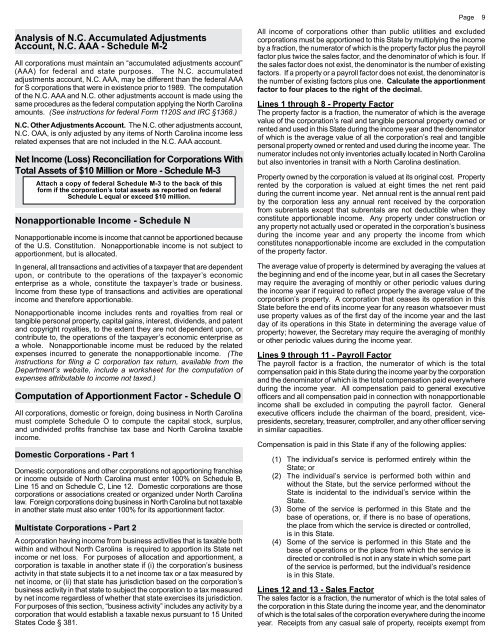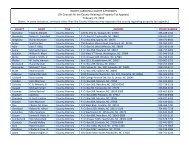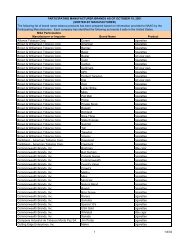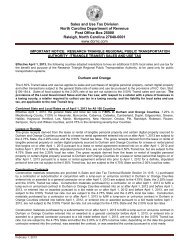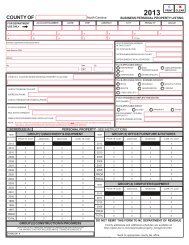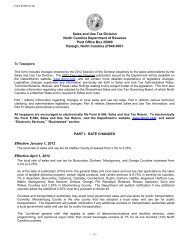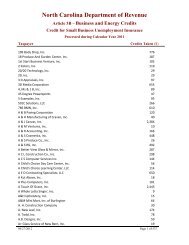North Carolina S Corporation Tax Return Instructions
North Carolina S Corporation Tax Return Instructions
North Carolina S Corporation Tax Return Instructions
You also want an ePaper? Increase the reach of your titles
YUMPU automatically turns print PDFs into web optimized ePapers that Google loves.
Analysis of N.C. Accumulated Adjustments<br />
Account, N.C. AAA - Schedule M-2<br />
All corporations must maintain an “accumulated adjustments account”<br />
(AAA) for federal and state purposes. The N.C. accumulated<br />
adjustments account, N.C. AAA, may be different than the federal AAA<br />
for S corporations that were in existence prior to 1989. The computation<br />
of the N.C. AAA and N.C. other adjustments account is made using the<br />
same procedures as the federal computation applying the <strong>North</strong> <strong>Carolina</strong><br />
amounts. (See instructions for federal Form 1120S and IRC §1368.)<br />
N.C. Other Adjustments Account. The N.C. other adjustments account,<br />
N.C. OAA, is only adjusted by any items of <strong>North</strong> <strong>Carolina</strong> income less<br />
related expenses that are not included in the N.C. AAA account.<br />
Net Income (Loss) Reconciliation for <strong>Corporation</strong>s With<br />
Total Assets of $10 Million or More - Schedule M-3<br />
Attach a copy of federal Schedule M-3 to the back of this<br />
form if the corporation’s total assets as reported on federal<br />
Schedule L equal or exceed $10 million.<br />
Nonapportionable Income - Schedule N<br />
Nonapportionable income is income that cannot be apportioned because<br />
of the U.S. Constitution. Nonapportionable income is not subject to<br />
apportionment, but is allocated.<br />
In general, all transactions and activities of a taxpayer that are dependent<br />
upon, or contribute to the operations of the taxpayer’s economic<br />
enterprise as a whole, constitute the taxpayer’s trade or business.<br />
Income from these type of transactions and activities are operational<br />
income and therefore apportionable.<br />
Nonapportionable income includes rents and royalties from real or<br />
tangible personal property, capital gains, interest, dividends, and patent<br />
and copyright royalties, to the extent they are not dependent upon, or<br />
contribute to, the operations of the taxpayer’s economic enterprise as<br />
a whole. Nonapportionable income must be reduced by the related<br />
expenses incurred to generate the nonapportionable income. (The<br />
instructions for filing a C corporation tax return, available from the<br />
Department’s website, include a worksheet for the computation of<br />
expenses attributable to income not taxed.)<br />
Computation of Apportionment Factor - Schedule O<br />
All corporations, domestic or foreign, doing business in <strong>North</strong> <strong>Carolina</strong><br />
must complete Schedule O to compute the capital stock, surplus,<br />
and undivided profits franchise tax base and <strong>North</strong> <strong>Carolina</strong> taxable<br />
income.<br />
Domestic <strong>Corporation</strong>s - Part 1<br />
Domestic corporations and other corporations not apportioning franchise<br />
or income outside of <strong>North</strong> <strong>Carolina</strong> must enter 100% on Schedule B,<br />
Line 15 and on Schedule C, Line 12. Domestic corporations are those<br />
corporations or associations created or organized under <strong>North</strong> <strong>Carolina</strong><br />
law. Foreign corporations doing business in <strong>North</strong> <strong>Carolina</strong> but not taxable<br />
in another state must also enter 100% for its apportionment factor.<br />
Multistate <strong>Corporation</strong>s - Part 2<br />
A corporation having income from business activities that is taxable both<br />
within and without <strong>North</strong> <strong>Carolina</strong> is required to apportion its State net<br />
income or net loss. For purposes of allocation and apportionment, a<br />
corporation is taxable in another state if (i) the corporation’s business<br />
activity in that state subjects it to a net income tax or a tax measured by<br />
net income, or (ii) that state has jurisdiction based on the corporation’s<br />
business activity in that state to subject the corporation to a tax measured<br />
by net income regardless of whether that state exercises its jurisdiction.<br />
For purposes of this section, “business activity” includes any activity by a<br />
corporation that would establish a taxable nexus pursuant to 15 United<br />
States Code § 381.<br />
Page 9<br />
All income of corporations other than public utilities and excluded<br />
corporations must be apportioned to this State by multiplying the income<br />
by a fraction, the numerator of which is the property factor plus the payroll<br />
factor plus twice the sales factor, and the denominator of which is four. If<br />
the sales factor does not exist, the denominator is the number of existing<br />
factors. If a property or a payroll factor does not exist, the denominator is<br />
the number of existing factors plus one. Calculate the apportionment<br />
factor to four places to the right of the decimal.<br />
Lines 1 through 8 - Property Factor<br />
The property factor is a fraction, the numerator of which is the average<br />
value of the corporation’s real and tangible personal property owned or<br />
rented and used in this State during the income year and the denominator<br />
of which is the average value of all the corporation’s real and tangible<br />
personal property owned or rented and used during the income year. The<br />
numerator includes not only inventories actually located in <strong>North</strong> <strong>Carolina</strong><br />
but also inventories in transit with a <strong>North</strong> <strong>Carolina</strong> destination.<br />
Property owned by the corporation is valued at its original cost. Property<br />
rented by the corporation is valued at eight times the net rent paid<br />
during the current income year. Net annual rent is the annual rent paid<br />
by the corporation less any annual rent received by the corporation<br />
from subrentals except that subrentals are not deductible when they<br />
constitute apportionable income. Any property under construction or<br />
any property not actually used or operated in the corporation’s business<br />
during the income year and any property the income from which<br />
constitutes nonapportionable income are excluded in the computation<br />
of the property factor.<br />
The average value of property is determined by averaging the values at<br />
the beginning and end of the income year, but in all cases the Secretary<br />
may require the averaging of monthly or other periodic values during<br />
the income year if required to reflect properly the average value of the<br />
corporation’s property. A corporation that ceases its operation in this<br />
State before the end of its income year for any reason whatsoever must<br />
use property values as of the first day of the income year and the last<br />
day of its operations in this State in determining the average value of<br />
property; however, the Secretary may require the averaging of monthly<br />
or other periodic values during the income year.<br />
Lines 9 through 11 - Payroll Factor<br />
The payroll factor is a fraction, the numerator of which is the total<br />
compensation paid in this State during the income year by the corporation<br />
and the denominator of which is the total compensation paid everywhere<br />
during the income year. All compensation paid to general executive<br />
officers and all compensation paid in connection with nonapportionable<br />
income shall be excluded in computing the payroll factor. General<br />
executive officers include the chairman of the board, president, vicepresidents,<br />
secretary, treasurer, comptroller, and any other officer serving<br />
in similar capacities.<br />
Compensation is paid in this State if any of the following applies:<br />
(1) The individual’s service is performed entirely within the<br />
State; or<br />
(2) The individual’s service is performed both within and<br />
without the State, but the service performed without the<br />
State is incidental to the individual’s service within the<br />
State.<br />
( ) Some of the service is performed in this State and the<br />
base of operations, or, if there is no base of operations,<br />
the place from which the service is directed or controlled,<br />
is in this State.<br />
(4) Some of the service is performed in this State and the<br />
base of operations or the place from which the service is<br />
directed or controlled is not in any state in which some part<br />
of the service is performed, but the individual’s residence<br />
is in this State.<br />
Lines 12 and 13 - Sales Factor<br />
The sales factor is a fraction, the numerator of which is the total sales of<br />
the corporation in this State during the income year, and the denominator<br />
of which is the total sales of the corporation everywhere during the income<br />
year. Receipts from any casual sale of property, receipts exempt from


